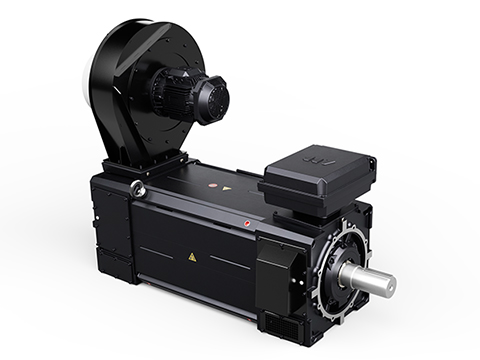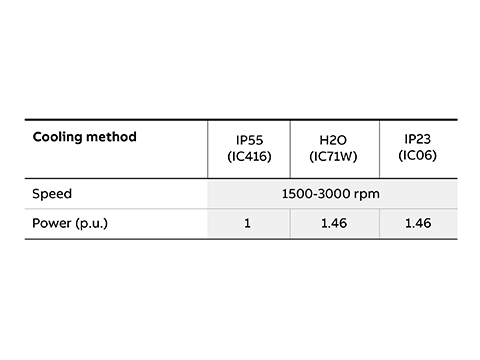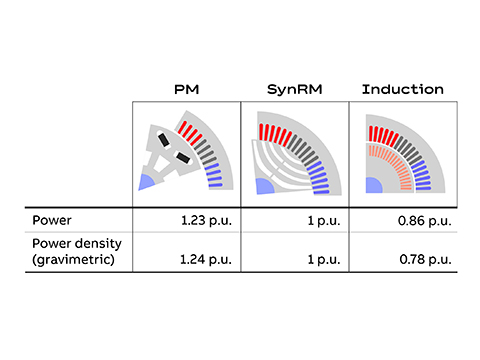
Posted to News on 29th Apr 2025, 09:16
High Dynamic Performance motors evolve to offer new dimensions in energy efficiency and power density
High Dynamic Performance (HDP) induction motors have a well-established reputation for turning fierce force into relentless rotation. Through ABB's commitment to continuous innovation, the portfolio has now evolved to include two new options: synchronous reluctance motor (SynRM) technology for enhanced energy efficiency and permanent magnet (PM) technology for optimised power density. Dr. Ghanshyam Shrestha, R&D Technology Manager at ABB IEC Low Voltage Motors, explains the background.

ABB developed its comprehensive range of HDP motors, also known as square frame induction motors, specifically for industrial machine use. To meet the needs of OEMs, it includes sizes up to 2MW and high-speed and water-cooled alternatives. The range creates new opportunities for machine builders to improve their replacement motor offering, while also helping them develop innovative machine designs.
The key advantage of our HDP motors is market-leading power density. That means any motor of a given frame size can deliver a higher power output than a corresponding standard machine motor. Another important advantage is the low rotor inertia, which is an attractive feature in high power density applications such as extruders, cranes and test benches. This enables faster reversing of the motor's rotational direction, hence speeding up the machine's back-and-forth motion - a critical factor for smooth and safe operation.
Furthermore, the HDP motors are developed alongside and matched perfectly with ABB's variable speed drives (VSDs). Optimised as complete system solutions, the HDP motor-and-drive packages offer the highest levels of performance together with advanced speed control and energy efficiency. These benefits have enabled our HDP motors to become market leaders. However, it has become clear that new customer needs are emerging, so as part of ABB's "engineered to outrun" philosophy, we have added some important innovations to the portfolio.
Synchronous reluctance technology boosts energy efficiency
Until recently, the most important consideration for users of HDP motors has always been the capability to support extremely variable operational profiles in terms of speed and torque. So, while energy efficiency has always been an important factor, it is now growing in significance. This change in outlook is inspired by new legislation, such as in Germany, that incentivizes the adoption of motors that deliver IE5 Ultra-Premium Efficiency.
We found that the most simple, cost-effective way to achieve IE5 was to take advantage of the modular construction of the HDP motor and adapt it to use magnet-free synchronous reluctance (SynRM) technology. While the static stator inside the square frame housing is unchanged, the innovation is in the rotor. This is made from laminated iron layers which form a light but solid construction that allows magnetism to flow through it.
The rotor's shape is precisely designed to guide magnetic reluctance within it. The result is that the rotor aligns itself to the magnetic flux produced by the stator coils, essentially "locking" into position. This means it rotates at exactly the same speed as the magnetic flux, ie synchronously, hence the name synchronous reluctance motor. The rotor does not contain magnets or rare earth-based components, and manufacturing it requires less material than a traditional motor.
The rotation of the magnetic flux produced by the stator, and therefore the speed of the rotor, is controlled by the VSD that is a standard element in the HDP package. The SynRM design ensures significantly lower energy losses than a comparable induction motor, mainly because it has no rotor losses. This results in a lower running temperature, especially for the bearings that run at about 20degC lower than the induction version. Together with the simple rotor structure without windings, this reduces service needs and the risk of failure compared to traditional induction motors.
An additional technical advantage of synchronous technology is that the speed of the motor at the shaft is known precisely, while for induction motors knowing the precise rotor speed needs an additional encoder or other measurement sensor.
HDP with SynRM rotor offers even lower inertia
Low inertia is an established virtue of HDP motors. With the SynRM design, it gets even better. The reason is that the rotor in an induction motor is constructed from iron and steel, while the design of the SynRM rotor means it is effectively 50% air, making it much lighter. Furthermore, with an induction motor there is always some lag between a control signal and the response. While with a SynRM motor, the response is instant.
Low inertia, controllability and IE5 efficiency are already proving a winning combination for machine builders producing extrusion equipment for a wide range of industries, including plastics and rubber, food, and pharmaceuticals.
One of the vital elements for the customer is the stable speed/torque offered by this solution. The HDP SynRM motor means that if another machine causes some disruption to the production process the extruder speed remains stable. This eliminates the risk of the extruded profile becoming deformed, that would otherwise result in a poor-quality product. In this example, using SynRM technology is not just about efficiency, it is also about quality and reducing waste.
Permanent magnet motor technology maximises power density
When it comes to optimizing the performance of our low voltage motors, ABB is technology-agnostic. Our R&D teams have investigated the use of different motor technologies and different cooling environments for the HDP motors. We now offer permanent magnet (PM) rotor technology where customers require the highest possible performance within the smallest possible installation footprint.
Developed from synchronous motors, ABB's low voltage PM motors combine the high-speed accuracy of synchronous technology with the robust design of induction motors. They can deliver very high torque from small motor sizes at low speed with high efficiency.
In a similar way to the SynRM version, the modular construction of the HDP motor enables it to be readily adapted to use a PM rotor. It should be noted that the PM motor output power and gravimetric power density (the available power per unit mass) increases by 23-24% compared to the SynRM motor for the same size and performance, while the SynRM motor power increases by around 16% over the induction motor, and the gravimetric power density increases by 28%.
Flexibility in cooling
In addition to the various options in rotor technology, the HDP portfolio also offers three different types of cooling: standard air cooling to IP55, water cooling and forced air cooling to IP23. For the same package, both water-cooling and forced-air cooling enable around a 46% increase in power. An added feature of water-cooling is that it will significantly reduce noise, which could be an important benefit in a busy production environment.
For the majority of machine-building applications, ABB's HDP motors will remain the ideal choice well into the future. But now, thanks to our continuous innovation, machine builders can also call on SynRM or PM technology for the most demanding designs that require the ultimate in energy efficiency or power density.
Want the latest machine building news straight to your inbox? Become a MachineBuilding member for free today >>
ABB Automation Technologies (Drives and Motors)
3100 Daresbury Park
Daresbury
WA4 4BY
UNITED KINGDOM
44 1925 741 111

















